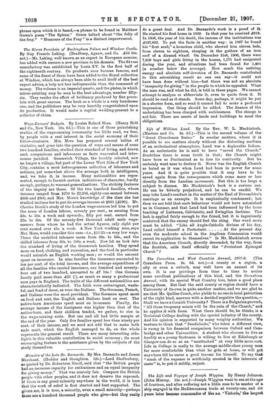Wage-Earners' Budgets. By Louise Bolard More. (Henry Holt and Co.,
New York. 10s. 6d.)—This is one of those painstaking studies of the wage-earning community too little read, we fear, by people with a real interest in the social economy of their fellow-creatures. Mrs. More has prepared several tables of statistics, and gone into the question of ways and means of some two hundred families, studied their standard of living, and drawn such comparisons and inferences as facts warranted and inter- course justified. Greenwich Village, the locality selected, now no longer a village, but part of the Lower West Side of New York City, contains a most heterogeneous collection of labourers and artisans, yet somewhat above the average both in intelligence, and, we take it, in income. Many nationalities are repre- sented, enough to furnish certain indications of character, hardly enough, perhaps, to warrant generalisations. The striking features of the inquiry are these. Of the two hundred families, whose incomes ranged from $250 to $2,256, eighty-one earned between $600 and $900, and Mrs. More's knowledge of the class she has studied inclines her to put its average income at $850 (4190). Mr. Charles Booth's study of the London wage-earners led him to put the mass of London labour, seventy per cent., as earning from 22s. to 50s. a week and upwards ; fifty per cent. earned from 22s. to 30s. Of the seventy-five thousand adult male wage- earners from whom he had the actual figures, only eight per cent. earned over 45s. 'a week. A New York working man, says Mrs. More, would consider this sum—i.e., $11.25—a very low wage. There the unskilled labourer earns from 38s. to 56s., and the skilled labourer from 60s. to 100s. a week. Now let us look into the standard of living of the Greenwich families. They spend more on food, clothing, and recreation, and the food in particular would astonish an English working man ; so would the amount spent on insurance. In nine families the insurance amounted to ten per cent. of the total income, and the average expenditure of all the families who carried insurance, one hundred and seventy- four out of two hundred, amounted to £7 105. ! One German family paid more than 425 (!), as much as many a professional man pays in England. The traits of the different nationalities are characteristically indicated. The Irish were extravagant, waste- ful, and fond of dress, as were the Italians. The Germans, French, and Italians were the most provident. The Germans spent most on food and rent, the English and Italians least on rent. The native-born Americans spent most on insurance. Finally, the average income of the foreigners was higher than that of the native-born, and their children tended, we gather, to rise in the wage-earning scale. But one and all had little margin at the end of the year. Only five families spent less than ninety per cent. of their income, and we need not add that to make both ends meet, which the English managed to do, on• the whole represents the general result. There are many interesting side- lights in this valuable contribution to social economy ; its most encouraging feature is the assistance given by the subjects of the study themselves.














































 Previous page
Previous page